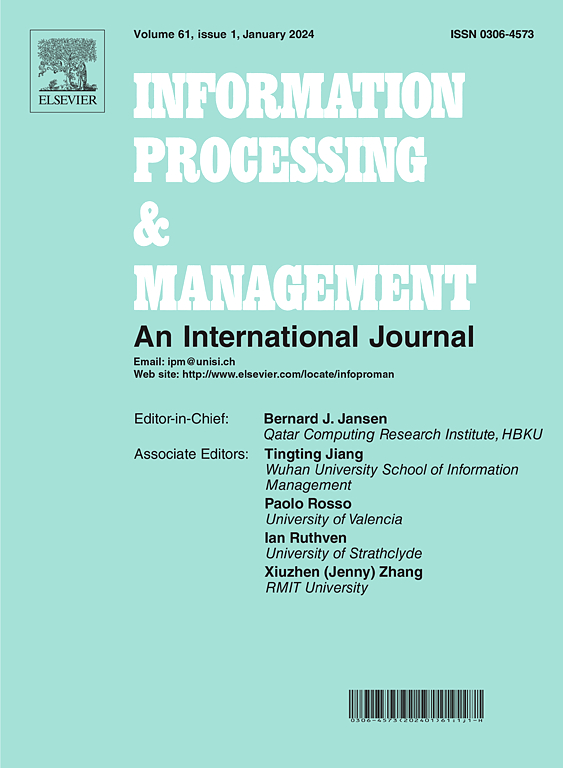Motif-based Contrastive Graph Clustering with clustering-oriented prompt
IF 7.4
1区 管理学
Q1 COMPUTER SCIENCE, INFORMATION SYSTEMS
引用次数: 0
Abstract
Graph contrastive learning has shown significant promise in graph clustering, yet prevalent approaches face two limitations: (1) most existing methods primarily capture lower-order adjacency structures, overlooking high-order motifs that are essential building blocks of the network; (2) most of them do not address false-negative pairs and lack cluster-oriented guidance, potentially embedding irrelevant information in the node representations. To overcome these issues, we introduce a novel Motif-based Contrastive Graph Clustering approach with Clustering-Oriented Prompt (MCGC). Firstly, MCGC employs a specialized Siamese encoder network to obtain both lower-order and higher-order node embeddings. The encoder processes two views of the graph: one based on lower-order adjacency and the other on higher-order motif structures, where higher-order motif (such as triangles) is extracted using motif adjacency matrices. Then, structural contrastive learning is used to ensure cross-view structural consistency. Furthermore, node-level contrastive learning is designed to enhance the discriminative capability of node embeddings, while interactions between samples and centroids provide clustering-oriented prompts. Finally, a parameter-shared MLP aligns embeddings in a unified clustering space, refined by cluster-level contrastive learning. These contrastive learning strategy ensures better-defined cluster boundaries and improves the quality of node representations. The approach is versatile and can be applied in recommendation systems, where clustering similar users enhances personalized recommendations, and in anomaly detection, where it helps identify unusual patterns or outliers in transaction or social networks. Experimental results on six datasets demonstrate that MCGC outperforms state-of-the-art algorithms. For example, on the EAT dataset, MCGC achieves 58.68% in ACC, surpassing the runner-up (CCGC) by 4.71%, demonstrating the effectiveness of motif-based contrastive learning in improving clustering quality. The source code is available at: https://github.com/CSLab208/MCGC-Motif-based.
面向聚类提示的基于母元的对比图聚类
图对比学习在图聚类中显示出巨大的前景,但流行的方法面临两个局限性:(1)大多数现有方法主要捕获低阶邻接结构,忽略了作为网络基本构建块的高阶基元;(2)大多数算法没有处理假阴性对,缺乏面向聚类的引导,可能会在节点表示中嵌入不相关信息。为了克服这些问题,我们引入了一种新的基于motif的对比图聚类方法,该方法具有面向聚类的提示(MCGC)。首先,MCGC采用一种专门的暹罗编码器网络来获得低阶和高阶节点嵌入。编码器处理图的两个视图:一个基于低阶邻接,另一个基于高阶基元结构,其中高阶基元(如三角形)是使用基元邻接矩阵提取的。然后,使用结构对比学习来确保跨视图结构一致性。此外,节点级对比学习旨在增强节点嵌入的判别能力,而样本和质心之间的相互作用提供了面向聚类的提示。最后,一个参数共享的MLP在统一的聚类空间中对齐嵌入,通过聚类级对比学习进行改进。这些对比学习策略确保了更好地定义集群边界,提高了节点表示的质量。该方法是通用的,可以应用于推荐系统,其中聚类相似用户增强个性化推荐,以及异常检测,其中它有助于识别异常模式或交易或社交网络中的异常值。在六个数据集上的实验结果表明,MCGC优于最先进的算法。例如,在EAT数据集上,MCGC的ACC准确率达到58.68%,超过第二名(CCGC) 4.71%,证明了基于motif的对比学习在提高聚类质量方面的有效性。源代码可从https://github.com/CSLab208/MCGC-Motif-based获得。
本文章由计算机程序翻译,如有差异,请以英文原文为准。
求助全文
约1分钟内获得全文
求助全文
来源期刊

Information Processing & Management
工程技术-计算机:信息系统
CiteScore
17.00
自引率
11.60%
发文量
276
审稿时长
39 days
期刊介绍:
Information Processing and Management is dedicated to publishing cutting-edge original research at the convergence of computing and information science. Our scope encompasses theory, methods, and applications across various domains, including advertising, business, health, information science, information technology marketing, and social computing.
We aim to cater to the interests of both primary researchers and practitioners by offering an effective platform for the timely dissemination of advanced and topical issues in this interdisciplinary field. The journal places particular emphasis on original research articles, research survey articles, research method articles, and articles addressing critical applications of research. Join us in advancing knowledge and innovation at the intersection of computing and information science.
 求助内容:
求助内容: 应助结果提醒方式:
应助结果提醒方式:


